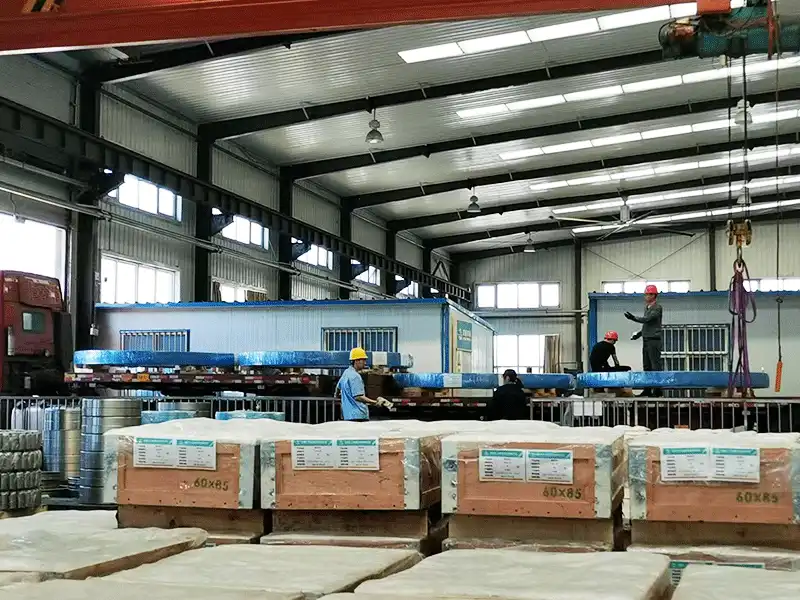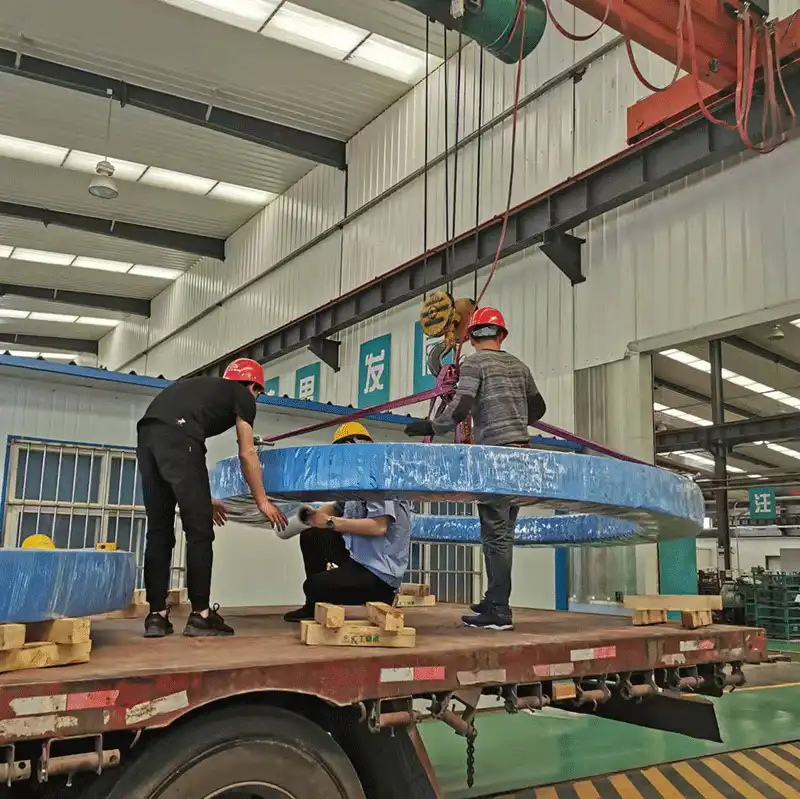What are the Common Materials for External Gears in Slewing Ring Bearings?
Slewing ring bearings are critical components in various industrial applications, serving as pivotal mechanical elements that enable rotation and load transmission in complex machinery. The external gear system plays a crucial role in the performance, durability, and efficiency of these bearings. Understanding the materials used for external gears is essential for engineers, designers, and industry professionals seeking to optimize mechanical performance and reliability.

How Do Material Choices Impact the Performance of External Gears in Slewing Ring Bearings?
Material selection is a critical determinant of external gear performance in slewing ring bearings. The intricate interplay between material properties and mechanical requirements demands a nuanced approach to material engineering. Engineers must carefully consider multiple factors when selecting materials, including load-bearing capacity, wear resistance, thermal stability, and environmental conditions.
High-carbon steel emerges as a predominant material for external gears due to its exceptional mechanical properties. The alloy's unique composition provides a remarkable balance between hardness and ductility, enabling gears to withstand significant stress and repeated loading cycles. Through precise heat treatment processes such as carburizing and quenching, manufacturers can enhance the surface hardness while maintaining a relatively soft and resilient core structure.
Chromium-molybdenum steels represent another sophisticated material choice for external gears. These alloy steels exhibit superior strength-to-weight ratios and exceptional resistance to fatigue and thermal stress. The addition of chromium and molybdenum creates a microstructure that significantly improves the material's hardenability and overall mechanical performance. In complex industrial environments where temperature fluctuations and intense mechanical loads are common, these advanced steel alloys provide unparalleled reliability.
Advanced ceramic materials have also emerged as innovative alternatives for External Gear Slewing Bearing manufacturing. Technological advancements have enabled the development of silicon nitride and tungsten carbide ceramics that offer extraordinary wear resistance and thermal stability. These materials demonstrate remarkable performance in extreme operating conditions, presenting engineers with cutting-edge solutions for challenging mechanical applications.
The selection process involves comprehensive analysis of anticipated operational parameters. Factors such as rotational speed, load distribution, environmental exposure, and expected service life must be meticulously evaluated. Computational modeling and simulation technologies now allow engineers to predict material behavior under various stress conditions, facilitating more informed material selection strategies.

What Are the Most Durable Materials for External Gears in Heavy-Duty Applications?
Heavy-duty industrial applications demand materials that can withstand extreme mechanical stress and environmental challenges. The selection of durable materials for external gears becomes paramount in sectors like mining, construction, maritime engineering, and heavy machinery manufacturing.
Specialized tool steels, particularly AISI H13 and D2 grades, have gained significant recognition for their exceptional durability in External Gear Slewing Bearing manufacturing. These high-chromium tool steels offer remarkable resistance to wear, thermal fatigue, and mechanical stress. The sophisticated alloying process creates a microstructure capable of maintaining dimensional stability under intense operational conditions.
Maraging steels represent another breakthrough in materials engineering for external gears. Characterized by their unique nickel-cobalt-molybdenum composition, these advanced alloys demonstrate extraordinary strength and toughness. Unlike conventional steels, maraging steels achieve high strength through precipitation hardening rather than traditional carbon content, resulting in superior mechanical properties with minimal brittleness.
Powder metallurgy techniques have revolutionized material development for external gears. By carefully controlling particle size, composition, and consolidation processes, manufacturers can create materials with unprecedented performance characteristics. Sintered steel alloys exhibit enhanced density, improved homogeneity, and more precise microstructural control compared to traditional casting methods.
Advanced surface treatments further augment the durability of external gear materials. Techniques like physical vapor deposition (PVD), chemical vapor deposition (CVD), and plasma nitriding create extremely hard, wear-resistant surface layers. These treatments can significantly extend the operational lifespan of external gears by reducing friction, preventing surface degradation, and enhancing overall mechanical performance.

Why Do Manufacturers Prefer Specific Materials for Slewing Ring Bearing External Gears?
The strategic selection of materials for External Gear Slewing Bearings reflects a complex interplay of technical, economic, and practical considerations. Manufacturers must balance performance requirements with production costs, manufacturing feasibility, and long-term reliability.
Cost-effectiveness remains a critical driver in material selection. While advanced materials like ceramics and specialized alloys offer superior performance, their prohibitive manufacturing expenses often limit widespread adoption. High-carbon steels and standard alloy compositions provide an optimal compromise between performance and economic viability.
Standardization and global manufacturing practices significantly influence material choices. International standards like ISO, ASTM, and DIN provide comprehensive guidelines for material specifications, ensuring consistency and compatibility across different industrial sectors. These standards establish precise requirements for mechanical properties, chemical composition, and performance characteristics.
Recyclability and sustainability have emerged as important considerations in material selection. Manufacturers increasingly prioritize materials that can be efficiently recycled or have minimal environmental impact during production and disposal. Steel alloys, with their well-established recycling infrastructure, align perfectly with these evolving sustainability objectives.
The global supply chain and material availability also play crucial roles in determining external gear materials. Manufacturers must consider the accessibility of raw materials, production capabilities, and potential geopolitical constraints that might affect material sourcing.
Conclusion
The selection of materials for external gears in slewing ring bearings represents a sophisticated engineering challenge. By carefully analyzing mechanical requirements, environmental conditions, and economic factors, manufacturers can develop optimal solutions that maximize performance, durability, and reliability.

Luoyang Huigong Bearing Technology Co., Ltd. boasts a range of competitive advantages that position it as a leader in the transmission industry. Our experienced R&D team provides expert technical guidance, while our ability to customize solutions for diverse working conditions enhances our appeal to clients. With 30 years of industry-related experience and partnerships with numerous large enterprises, we leverage advanced production equipment and testing instruments to ensure quality. Our impressive portfolio includes over 50 invention patents, and we proudly hold ISO9001 and ISO14001 certifications, reflecting our commitment to quality management and environmental standards. Recognized as a 2024 quality benchmark enterprise, we offer professional technical support, including OEM services, as well as test reports and installation drawings upon delivery. Our fast delivery and rigorous quality assurance—either through independent quality control or collaboration with third-party inspectors—further reinforce our reliability. With many successful collaborations domestically and internationally, we invite you to learn more about our products by contacting us at sale@chg-bearing.com or calling our hotline at +86-0379-65793878.
References
1. Jones, R. M. (2019). Advanced Materials in Mechanical Engineering. Springer Publications.
2. Williams, J. C. (2020). Metallurgy of Specialized Industrial Alloys. Cambridge University Press.
3. Rodriguez, M. A. (2018). Ceramic Materials in High-Stress Applications. Elsevier Scientific Press.
4. Thompson, S. R. (2021). Powder Metallurgy: Modern Manufacturing Techniques. Wiley & Sons.
5. Chen, L. (2017). Surface Treatment Technologies for Advanced Mechanical Components. CRC Press.
6. Nakamura, K. (2020). Materials Science in Industrial Applications. Springer Nature.
7. García, P. (2019). Durability Analysis of Engineering Materials. Academic Press.
8. Smith, D. R. (2018). Thermal and Mechanical Stress in Gear Systems. McGraw-Hill Education.
9. Kim, J. H. (2021). Advances in Material Engineering for Heavy-Duty Applications. Routledge.
10. Müller, W. (2020). Computational Modeling of Material Performance. Birkhauser Verlag.

